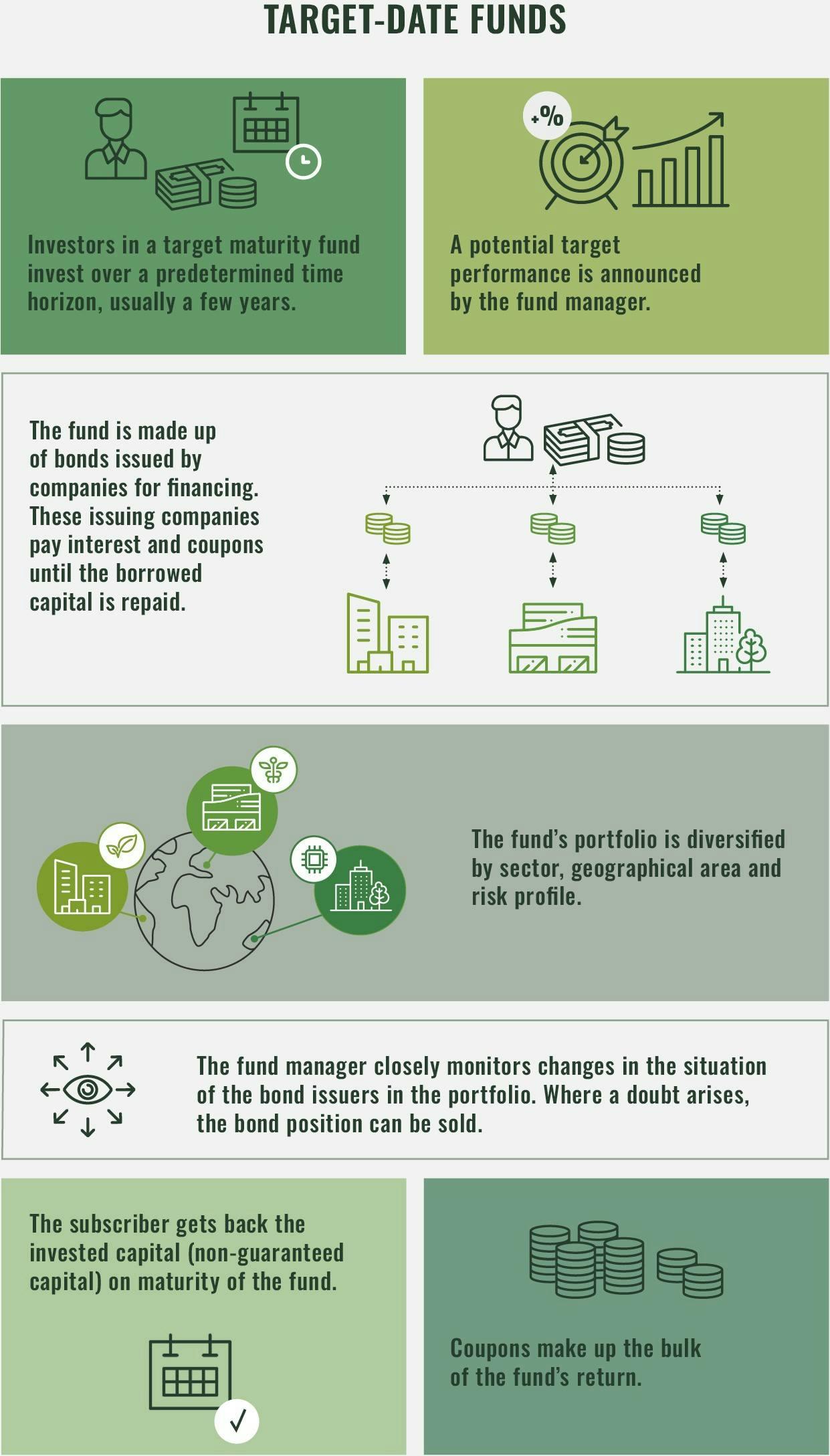Flash Note

Target maturity bond funds in the spotlight
- Published
-
Length
4 minute(s) read
Target maturity bond funds combine the characteristics of bonds* with the diversification and selectivity of a traditional fixed income fund.
With the rising interest rate environment and the resulting sharp re-pricing of bond yields, target maturity funds have made a major comeback on the market. Credit markets, mainly comprising bonds issued by companies to raise capital, offer particularly attractive yields at present.
Target maturity funds, also known as target date funds, comprise a diversified portfolio of mainly corporate bonds, enabling them to offer visibility on the potential performance that will be delivered at maturity.
*A bond is a debt instrument issued by a company, government or local authority. Bond investors lend to the issuer, who pays interest regularly on that loan. The capital amount is repaid on maturity of the bond. To learn more about bonds, see our dedicated article.
A predetermined lifespan
Investors in a target maturity fund invest over a predetermined time horizon, usually several years. However, they may sell this investment before its term; the sale value then depends on market conditions.
… and a target performance known in advance
The target maturity fund manager builds a bond portfolio. Each of these bonds bears an interest rate that generally defines the level of the interest payment. An investment strategy such as this makes it possible to announce a target performance over the entire life of the fund for the investor.
The fund manager uses a buy and hold strategy, keeping the bonds in the portfolio until they mature, i.e. until repayment of the capital borrowed by the companies issuing the bonds. On the fund’s maturity date, subscribers will receive the invested capital (non-guaranteed capital). It is the cumulative coupons paid by companies that will constitute the bulk of the fund’s return.
What are target maturity bond funds?

Source: Carmignac.
A diversified portfolio of corporate bonds
Credit markets provide access to a wide spectrum of corporate borrowers from a diverse range of business sectors and geographical areas and with diverse risk profiles.
The risk profile of each company can be established based on a risk rating issued by rating agencies that makes it possible, in particular, to measure its creditworthiness. For example, S & P Global’s rates borrowers on a scale from AAA to D, with the “D” rating being the lowest, indicating that the company has already defaulted or is likely to default. This rating is drawn from an analysis of the company's fundamentals, prospects and ability to meet its commitments, i.e. to pay the expected interest payments and repay the borrowed capital at maturity.
The level of interest paid by the company depends on this rating. The fund manager must find a good balance between the level of return to be received and the level of default risk to be assumed, by combining investment grade issuers, which are the least risky, with high yield issuers, which are riskier but offer higher returns.
In this context, the fund manager creates a diversified portfolio of corporate bonds with the aim of capturing good yield opportunities across all economic sectors (healthcare, energy, finance, etc.) and all regions of the world (developed and emerging markets), and spreading risks across several dozen if not hundreds of issuers.
Diversification of the portfolio helps to reduce the impact in the event of default by a single issuer. Additionally, by keeping the bonds in the portfolio until the capital has been repaid, the fund manager can avoid market volatility and changes in interest rates. Furthermore, these strategies offer a “receding risk” profile: the closer the fund’s maturity date, the lower its sensitivity to interest rate and credit risk.
Rigorous selection and monitoring
A target maturity fund’s bond portfolio is constructed by the manager using a rigorous selection process, with a focus on companies that can honour their regular interest payments and repayment of the capital due at maturity.
As part of this selection process, an in-depth analysis of the companies’ economic fundamentals, their financial health and their prospects is carried out. In particular, their business model, their sector, their competitive positioning and the macroeconomic outlook are considered.
In addition to this upfront analysis, the fund manager continues to monitor the solidity of the companies held in the portfolio throughout the life of the fund. They are likely to make purchases/sales of securities if a potential risk of non-repayment is identified. The fund manager will then sell this bond on the market.
In short, target maturity funds combine the characteristics of individual bonds (fixed maturity, target potential performance at maturity known in advance, reduction of the risk profile over time) with the diversification and selectivity of a traditional bond fund.

Source: Carmignac - For illustrative purposes only.
Investing in a target maturity fund
Target maturity funds are managed by seasoned professionals who are experts in selecting the right securities and diversifying the risks and investments.
As a specialist in fixed income markets for more than 30 years, Carmignac has used this time to hone its expertise in the various segments of this asset class, and particularly in credit. Our highly experienced fund managers have a demonstrated ability to create value in different market environments.
Our range of target maturity funds reflects this expertise.